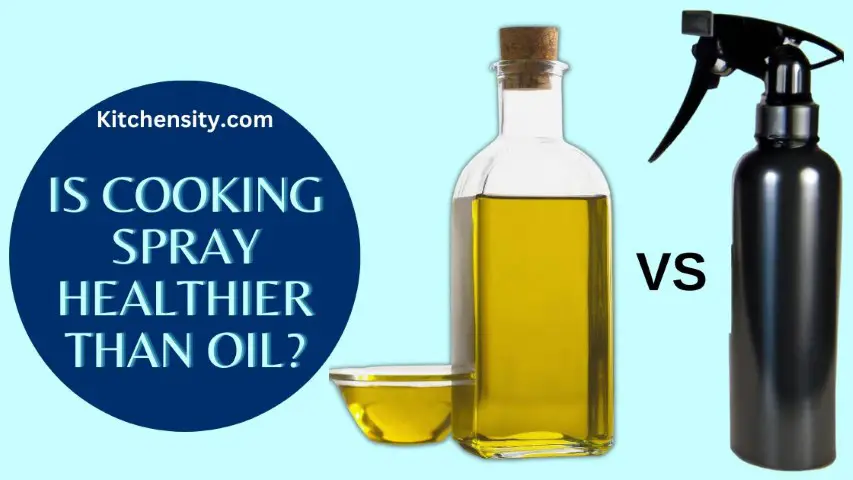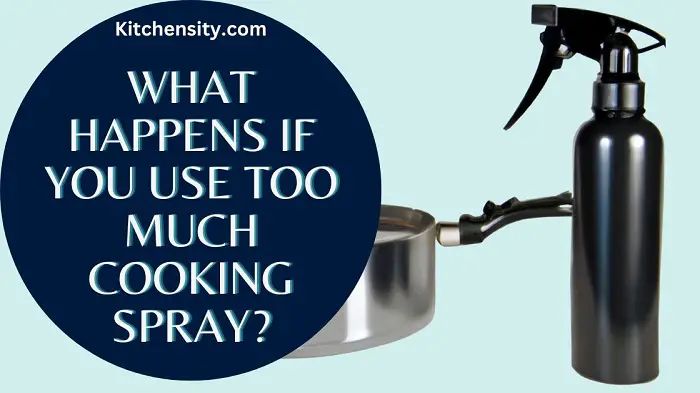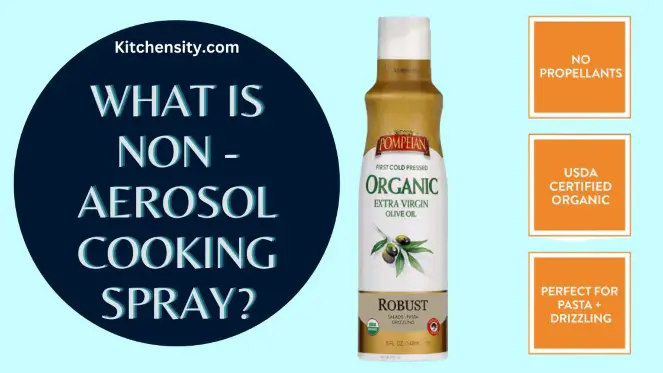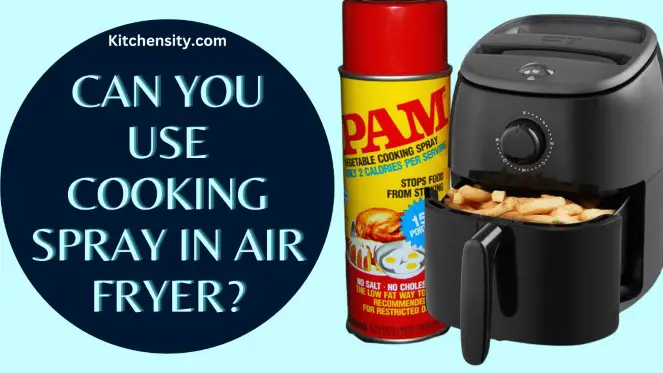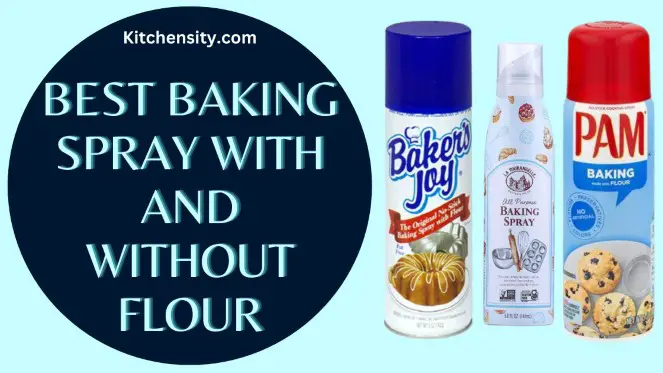If you love cooking, you must have used cooking sprays at some point.
Cooking sprays are convenient, and quick, and can help you reduce the amount of oil used in cooking.
However, if you don’t use them properly, they can leave a stubborn residue on your cookware and kitchen surfaces.
In this article, we will provide various tips and tricks on how to remove cooking spray residue from different surfaces.
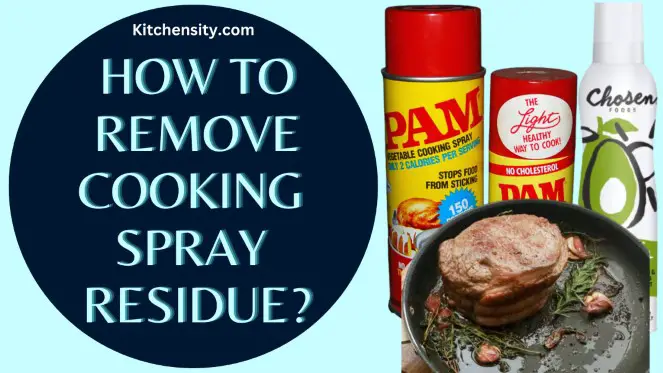
Table of Contents
- 1 How Do You Remove Cooking Spray Residue?
- 2 What Is Cooking Spray Residue?
- 3 Why Is It Important To Remove Cooking Spray Residue?
- 4 Different Types Of Surfaces Affected By Cooking Spray Residue
- 4.1 How To Remove Cooking Spray Residue From Non-Stick Cookware?
- 4.2 How To Remove Cooking Spray Residue From Stainless Steel Cookware?
- 4.3 How To Remove Cooking Spray Residue From Glass Surfaces?
- 4.4 How To Remove Cooking Spray Residue From The Oven?
- 4.5 How To Remove Cooking Spray Residue From Countertops?
- 5 How Do You Get Baked On Pam Off Cookie Sheets?
- 6 How To Remove Lecithin From A Pan?
- 7 How To Prevent Cooking Spray Residue?
- 8 Conclusion
- 9 YOU MAY ALSO LIKE
- 10 FAQs
- 10.1 Can I Use A Magic Eraser To Remove Cooking Spray Residue?
- 10.2 Is It Safe To Use Vinegar To Clean Stainless Steel Cookware?
- 10.3 Can Cooking Spray Residue Be Harmful?
- 10.4 Can I Use A Metal Scrubber To Clean Non-Stick Cookware?
- 10.5 How Often Should I Clean My Cookware And Kitchen Surfaces?
- 10.6 How Do You Clean Pam’s Residue?
How Do You Remove Cooking Spray Residue?
To remove cooking spray residue, use hot soapy water and a non-abrasive sponge to scrub the surface of the affected area. For tougher residue, try using a mixture of vinegar and baking soda to create a paste and apply it to the residue before scrubbing and rinsing.
What Is Cooking Spray Residue?
Cooking spray residue is the greasy and sticky film that remains on surfaces after using cooking spray.
It can accumulate on various surfaces, including cookware, countertops, and kitchen appliances.
Cooking spray residue can be challenging to remove and can leave surfaces feeling dirty and unclean.
If left unaddressed, cooking spray residue can also become a breeding ground for bacteria, which can be harmful to your health.
It’s important to clean cooking spray residue properly to maintain a clean and hygienic kitchen environment.
Also Read – Cooking Spray That Doesn’t Leave Residue
Why Is It Important To Remove Cooking Spray Residue?
- Cooking spray residue can become a breeding ground for bacteria and can also attract dust and dirt.
- It can also affect the taste and appearance of your food.
- If not removed, cooking spray residue can build up over time and become harder to remove and may damage the cookware.
Different Types Of Surfaces Affected By Cooking Spray Residue
Cooking spray residue can affect different surfaces, including non-stick cookware, stainless steel cookware, glass surfaces, oven, and countertops.
The type of surface determines the cleaning method you should use.
How To Remove Cooking Spray Residue From Non-Stick Cookware?
Non-stick cookware is a popular choice in many kitchens because it’s easy to clean and prevents food from sticking to the surface.
However, cooking spray residue can build up on non-stick cookware and make it more challenging to keep the surface clean.
Here’s how you can remove cooking spray residue from non-stick cookware:
- Use A Gentle Dish Soap: Start by adding a small amount of gentle dish soap to warm water in a sink or basin. Place the non-stick cookware in the water and allow it to soak for a few minutes.
- Scrub With A Soft Brush Or Sponge: After soaking, use a soft-bristled brush or sponge to scrub the surface of the non-stick cookware. Avoid using abrasive scrubbers or steel wool, which can scratch the non-stick coating and damage the surface.
- Use Vinegar And Baking Soda:
- For stubborn cooking spray residue, try using a mixture of vinegar and baking soda.
- Mix equal parts of vinegar and baking soda to form a paste.
- Apply the paste to the surface of the non-stick cookware and let it sit for 10-15 minutes.
- Then, use a soft-bristled brush or sponge to scrub the surface, and rinse with warm water.
- Use A Non-Abrasive Cleaner: If the cooking spray residue is still not coming off, you can try using a non-abrasive cleaner that’s safe for non-stick surfaces. Follow the manufacturer’s instructions for the best results.
- Rinse And Dry: After cleaning the non-stick cookware, rinse it thoroughly with warm water and dry it with a clean, dry cloth.
It’s important to note that non-stick cookware can be delicate, and it’s essential to avoid using abrasive cleaners or scrubbers that can damage the surface.
Additionally, if you’re unsure about how to clean a particular type of non-stick cookware, consult the manufacturer’s instructions or contact their customer service for guidance.
Following these steps, you can remove cooking spray residue from non-stick cookware and keep it clean and hygienic.
Remember to clean non-stick cookware after every use to prevent residue buildup and prolong the life of the non-stick coating.
How To Remove Cooking Spray Residue From Stainless Steel Cookware?
Stainless steel cookware is a durable and popular option in many kitchens.
However, cooking spray residue can be difficult to remove from stainless steel cookware, leaving behind a sticky and greasy film.
Here are some steps you can follow to remove cooking spray residue from stainless steel cookware:
- Use A Degreaser:
- A degreaser is an effective cleaning solution for removing cooking spray residue from stainless steel cookware.
- Apply a small amount of degreaser to the surface of the cookware, and use a soft-bristled brush or sponge to scrub the surface.
- Rinse with warm water and dry with a clean cloth.
- Use White Vinegar:
- White vinegar is another effective cleaning solution for removing cooking spray residue from stainless steel cookware.
- Mix equal parts of white vinegar and water in a spray bottle, and spray the solution onto the surface of the cookware.
- Let it sit for a few minutes, and then use a soft-bristled brush or sponge to scrub the surface.
- Rinse with warm water and dry with a clean cloth.
- Use Baking Soda:
- Baking soda is a gentle abrasive that can help remove stubborn cooking spray residue from stainless steel cookware.
- Make a paste by mixing baking soda and water, and apply the paste to the surface of the cookware.
- Let it sit for 10-15 minutes, and then use a soft-bristled brush or sponge to scrub the surface.
- Rinse with warm water and dry with a clean cloth.
- Use A Stainless Steel Cleaner:
- If the cooking spray residue is still not coming off, you can try using a stainless steel cleaner.
- Apply a small amount of the cleaner to the surface of the cookware, and use a soft-bristled brush or sponge to scrub the surface.
- Rinse with warm water and dry with a clean cloth.
It’s important to note that stainless steel cookware can be easily scratched, so avoid using abrasive scrubbers or steel wool that can damage the surface.
Also, make sure to follow the manufacturer’s instructions when using cleaning solutions or products on stainless steel cookware.
Following these steps, you can effectively remove cooking spray residue from stainless steel cookware and keep it clean and shiny.
Regularly cleaning stainless steel cookware is important to prevent residue buildup and maintain its appearance and functionality.
How To Remove Cooking Spray Residue From Glass Surfaces?
Cooking spray residue on glass surfaces can be stubborn and difficult to remove. Here are some steps you can follow to remove cooking spray residue from glass surfaces:
- Use A Glass Cleaner:
- The easiest way to remove cooking spray residue from glass surfaces is to use a glass cleaner.
- Spray the cleaner onto the surface of the glass, and use a soft cloth or paper towel to wipe it clean.
- Repeat as necessary until the residue is removed.
- Use Vinegar And Water:
- If you don’t have a glass cleaner on hand, you can make your cleaning solution using vinegar and water.
- Mix equal parts of white vinegar and water in a spray bottle, and spray the solution onto the surface of the glass.
- Use a soft cloth or paper towel to wipe the surface clean.
- Repeat as necessary until the residue is removed.
- Use Baking Soda:
- Baking soda is a gentle abrasive that can help remove stubborn cooking spray residue from glass surfaces.
- Mix baking soda and water to make a paste, and apply the paste to the surface of the glass.
- Use a soft cloth or paper towel to rub the paste into the residue, and then wipe it clean with a damp cloth.
- Rinse with water and dry with a clean cloth.
- Use A Razor Blade:
- If the cooking spray residue is particularly stubborn, you can use a razor blade to scrape it off the glass surface.
- Hold the blade at a 45-degree angle and gently scrape the residue off the glass.
- Be careful not to apply too much pressure or scratch the glass.
It’s important to note that glass surfaces can be easily scratched, so avoid using abrasive scrubbers or steel wool that can damage the surface.
Also, make sure to follow the manufacturer’s instructions when using cleaning solutions or products on glass surfaces.
Following these steps, you can effectively remove cooking spray residue from glass surfaces and keep them clean and shiny.
Regularly cleaning glass surfaces is important to prevent residue buildup and maintain their appearance and functionality.
How To Remove Cooking Spray Residue From The Oven?
Cooking spray residue can often accumulate inside an oven, creating an unsightly mess and even affecting the taste of your food.
Fortunately, there are effective ways to remove this residue and restore your oven to its original state. Here are some methods you can try:
- Use Hot Water And A Sponge:
- One of the simplest ways to remove cooking spray residue from an oven is to use hot water and a sponge.
- First, wait for the oven to cool down completely.
- Then, dampen a sponge with hot water and use it to wipe away as much residue as possible.
- For tougher spots, you can also try using a non-abrasive scrubber.
- Use Baking Soda And Vinegar:
- Baking soda and vinegar are effective natural cleaning agents that can be used to remove stubborn cooking spray residue from an oven.
- First, mix a paste of baking soda and water and apply it to the affected areas.
- Let it sit for at least 15 minutes, then use a damp sponge to wipe away the residue.
- Next, spray the area with vinegar and wipe it clean with a damp cloth.
- Use Oven Cleaner:
- For more severe cases of cooking spray residue buildup, an oven cleaner may be necessary.
- Follow the instructions on the product carefully, making sure to wear gloves and provide adequate ventilation.
- Generally, you will need to spray the cleaner on the affected areas and let it sit for a certain amount of time before wiping it away with a damp cloth.
- Use A Steam Cleaner:
- If you have access to a steam cleaner, it can also be effective for removing cooking spray residue from an oven.
- Simply fill the cleaner with water and steam the affected areas, using a damp cloth to wipe away any residue.
In summary, removing cooking spray residue from an oven can be done with simple household items or with the use of commercial cleaners.
By following these tips, you can keep your oven clean and functioning properly.
How To Remove Cooking Spray Residue From Countertops?
Countertops are a common surface where cooking spray residue can accumulate. Here’s how you can remove it:
- Sprinkle baking soda on the countertop.
- Spray vinegar over the baking soda.
- Let the mixture sit for a few minutes.
- Scrub the countertop with a soft brush or sponge.
- Rinse the countertop with warm water.
- Dry the surface with a clean, dry cloth.
How Do You Get Baked On Pam Off Cookie Sheets?
Pam cooking spray can leave a stubborn residue on cookie sheets that can be difficult to remove.
Here are some steps you can follow to get baked-on Pam off of cookie sheets:
- Scrape Off Any Excess Residue: Use a plastic scraper or spatula to scrape off any excess cooking spray residue from the cookie sheet. Be gentle to avoid scratching the surface.
- Create A Cleaning Solution: Mix equal parts baking soda and water to make a paste. Apply the paste to the surface of the cookie sheet, paying particular attention to the areas with the most buildup.
- Let It Sit: Let the baking soda paste sit on the cookie sheet for 15-20 minutes. This will give the solution time to break down the cooking spray residue.
- Scrub The Surface: Use a non-abrasive sponge or cloth to gently scrub the surface of the cookie sheet, paying particular attention to the areas with the most buildup. Apply some pressure to help remove the residue, but be careful not to scratch the surface of the cookie sheet.
- Rinse And Dry: Rinse the cookie sheet with water and dry it with a clean towel. If any residue remains, repeat the process until the cookie sheet is clean.
It’s important to note that regular cleaning is the best way to prevent cooking spray residue from building up on your cookie sheets.
Make sure to clean your cookie sheets after each use with the appropriate cleaning solutions to maintain their appearance and functionality.
How To Remove Lecithin From A Pan?
Lecithin is a common ingredient in cooking sprays and can leave a sticky residue on pans after cooking.
Here are some steps you can follow to remove lecithin from a pan:
- Cool Down The Pan: Allow the pan to cool down completely before attempting to remove any residue.
- Add Dish Soap And Hot Water: Fill the pan with hot water and add a few drops of dish soap. Allow the pan to soak for several minutes.
- Scrub The Surface: Use a non-abrasive sponge or cloth to gently scrub the surface of the pan, paying particular attention to the areas with the most residue. Apply some pressure to help remove the residue, but be careful not to scratch the surface of the pan.
- Rinse And Dry: Rinse the pan with water and dry it with a clean towel. If any residue remains, repeat the process until the pan is clean.
- Try Vinegar And Baking Soda: If the dish soap and hot water solution don’t work, try mixing equal parts vinegar and baking soda to make a paste. Apply the paste to the surface of the pan and let it sit for several minutes before scrubbing and rinsing.
It’s important to note that regular cleaning is the best way to prevent lecithin residue from building up on your pans.
Make sure to clean your pans after each use with the appropriate cleaning solutions to maintain their appearance and functionality.
How To Prevent Cooking Spray Residue?
Preventing cooking spray residue is easier than removing it. Here are some tips:
- Use cooking spray sparingly.
- Use non-stick cookware with a high-quality non-stick coating.
- Use a cooking oil mister instead of a cooking spray.
- Clean cookware and surfaces immediately after use.
Conclusion
In conclusion, cooking spray residue can be a tough and stubborn problem to deal with, but with the right techniques and tools, it can be easily removed.
Whether you are dealing with non-stick cookware, stainless steel cookware, or glass surfaces, there are effective methods you can use to get rid of the sticky residue left behind by cooking spray.
By regularly cleaning your cookware and using alternative cooking methods, you can also prevent residue buildup in the first place.
Remember to always follow safety precautions and manufacturer’s instructions when cleaning your cookware to ensure its longevity and functionality.
With these tips and tricks, you can keep your cookware looking and performing like new.
YOU MAY ALSO LIKE
- Cooking Spray That Doesn’t Leave Residue
- What Cooking Spray is Best for Air Fryer?
- Can You Use Cooking Spray In An Air Fryer?
- Best Zero-Calorie Cooking Spray
- What Can I Use Instead Of Cooking Spray?
- Best Cooking Sprays For Eggs
- Best Cooking Sprays For Gas Grills
- Kirkland Canola Oil Cooking Spray Review
FAQs
-
Can I Use A Magic Eraser To Remove Cooking Spray Residue?
Yes, you can use a magic eraser to remove cooking spray residue from some surfaces, such as countertops and walls.
-
Is It Safe To Use Vinegar To Clean Stainless Steel Cookware?
Yes, vinegar is safe to use on stainless steel cookware. Just make sure to rinse the cookware thoroughly with warm water after cleaning.
-
Can Cooking Spray Residue Be Harmful?
Cooking spray residue can become a breeding ground for bacteria, which can be harmful to your health.
-
Can I Use A Metal Scrubber To Clean Non-Stick Cookware?
No, you should not use a metal scrubber on non-stick cookware, as it can scratch the non-stick coating and damage the surface.
-
How Often Should I Clean My Cookware And Kitchen Surfaces?
You should clean your cookware and kitchen surfaces after every use to prevent residue buildup.
-
How Do You Clean Pam’s Residue?
To clean Pam’s residue, you can use hot soapy water and a non-abrasive sponge to scrub the surface of the pan. For tougher residue, you can use a mixture of vinegar and baking soda to create a paste and apply it to the affected areas before scrubbing and rinsing.
Katrina Smith is a seasoned expert with over 25 years of experience in all things related to cooking and the kitchen. As an avid cook and kitchen enthusiast, she is passionate about sharing her knowledge and expertise on cookware, kitchen appliances, kitchen tips, and kitchen staples.
Through her articles and reviews, Katrina aims to inspire and help others improve their cooking skills, experiment with different ingredients, and invest in quality cookware and appliances.

